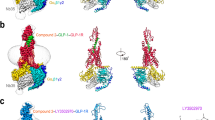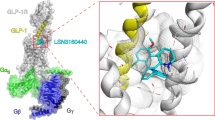Abstract
We report that 4-(3-(benzyloxy)phenyl)-2-ethylsulfinyl-6-(trifluoromethyl)pyrimidine (BETP), which behaves as a positive allosteric modulator at the glucagon-like peptide-1 receptor (GLP-1R), covalently modifies cysteines 347 and 438 in GLP-1R. C347, located in intracellular loop 3 of GLP-1R, is critical to the activity of BETP and a structurally distinct GLP-1R ago-allosteric modulator, N-(tert-butyl)-6,7-dichloro-3-(methylsulfonyl)quinoxalin-2-amine. We further show that substitution of cysteine for phenylalanine 345 in the glucagon receptor is sufficient to confer sensitivity to BETP.


Similar content being viewed by others
Accession codes
References
Baggio, L.L. & Drucker, D.J. Best Pract. Res., Clin. Endocrinol. Metab. 18, 531–554 (2004).
Willard, F.S. & Sloop, K.W. Exp. Diabetes Res. 2012, 470851 (2012).
Quoyer, J. et al. J. Biol. Chem. 285, 1989–2002 (2010).
Koole, C. et al. Mol. Pharmacol. 78, 456–465 (2010).
Verges, B., Bonnard, C. & Renard, E. Diabetes Metab. 37, 477–488 (2011).
Willard, F.S., Bueno, A.B. & Sloop, K.W. Exp. Diabetes Res. 2012, 709893 (2012).
Li, N., Lu, J. & Willars, G.B. PLoS ONE 7, e47936 (2012).
Teng, M. et al. Bioorg. Med. Chem. Lett. 17, 5472–5478 (2007).
Willard, F.S. et al. Mol. Pharmacol. 82, 1066–1073 (2012).
Wootten, D. et al. Mol. Pharmacol. 82, 281–290 (2012).
Sloop, K.W. et al. Diabetes 59, 3099–3107 (2010).
Eng, H. et al. Drug Metab. Dispos. 41, 1470–1479 (2013).
Baggio, L.L., Kim, J.-G. & Drucker, D.J. Diabetes 53, S205–S214 (2004).
Kim, W. & Egan, J.M. Pharmacol. Rev. 60, 470–512 (2008).
Takata, Y., Webster, N.J. & Olefsky, J.M. J. Biol. Chem. 266, 9135–9139 (1991).
Mathi, S.K., Chan, Y., Li, X. & Wheeler, M.B. Mol. Endocrinol. 11, 424–432 (1997).
Underwood, C.R., Knudsen, L.B., Garibay, P.W., Peters, G.H. & Reedtz-Runge, S. Peptides 49C, 100–108 (2013).
Wootten, D. et al. Mol. Pharmacol. 83, 822–834 (2013).
Vazquez, P., Roncero, I., Blazquez, E. & Alvarez, E. J. Endocrinol. 185, 35–44 (2005).
Hinke, S.A. et al. J. Biol. Chem. 275, 3827–3834 (2000).
Siu, F.Y. et al. Nature 499, 444–449 (2013).
Acknowledgements
We thank X. Chen, Y. Cao and K. Fennell (Worldwide Medicinal Chemistry, Pfizer PharmaTherapeutics Research and Development) for advice, constructs and preliminary experiments.
Author information
Authors and Affiliations
Contributions
W.M.N. conducted all of the experiments and analyzed the data. W.M.N., B.D.S., G.E.A. and C.L. designed PETP and developed a synthetic route for its preparation. W.M.N., J.-P.F., B.D.S., D.A.G., R.B.R., A.M.M., D.H. and P.A.C. conceived the experiments. W.M.N. and L.R.H. developed MS methods for identifying the site (or sites) at which BETP modifies GLP-1R. W.M.N. and P.A.C. wrote the paper.
Corresponding author
Ethics declarations
Competing interests
Declaration: W.N., J.-P.F., G.A., D.G., L.H., R.R., A.M., C.L., D.H. and P.C. are employees of Pfizer. The research was fully funded by Pfizer.
Supplementary information
Supplementary Text and Figures
Supplementary Results, Supplementary Figures 1–14 and Supplementary Table 1. (PDF 1307 kb)
Supplementary Data Set 1
BETP inhibitory activity across 64 proteins (XLSX 12 kb)
Rights and permissions
About this article
Cite this article
Nolte, W., Fortin, JP., Stevens, B. et al. A potentiator of orthosteric ligand activity at GLP-1R acts via covalent modification. Nat Chem Biol 10, 629–631 (2014). https://doi.org/10.1038/nchembio.1581
Received:
Accepted:
Published:
Issue Date:
DOI: https://doi.org/10.1038/nchembio.1581
- Springer Nature America, Inc.
This article is cited by
-
G protein-coupled receptors: structure- and function-based drug discovery
Signal Transduction and Targeted Therapy (2021)
-
Structural insights into G-protein-coupled receptor allostery
Nature (2018)
-
Human GLP-1 receptor transmembrane domain structure in complex with allosteric modulators
Nature (2017)
-
Full monty of family B GPCRs
Nature Chemical Biology (2017)
-
Structural insight into antibody-mediated antagonism of the Glucagon-like peptide-1 Receptor
Scientific Reports (2016)





